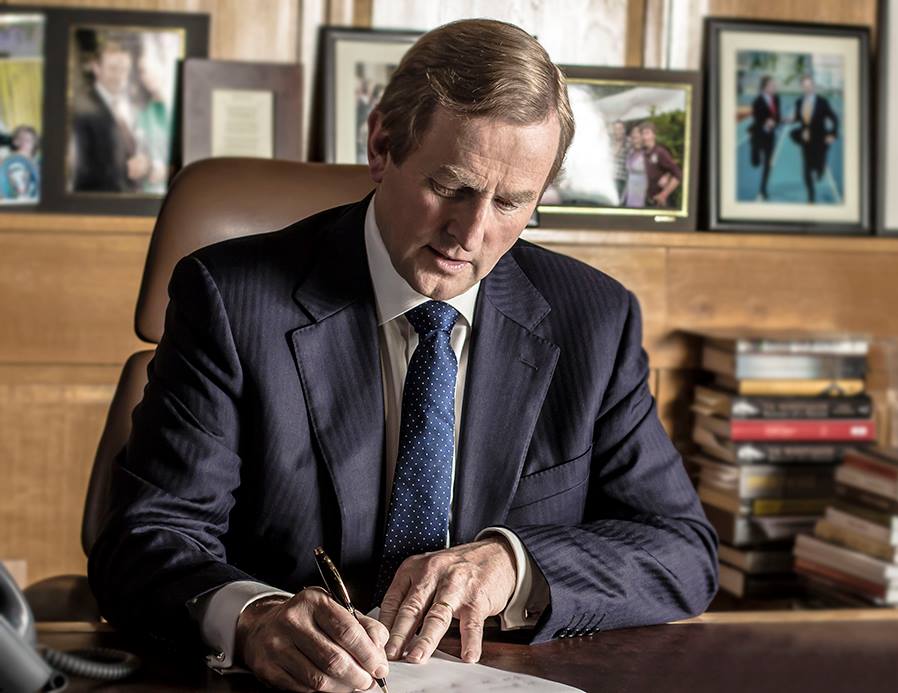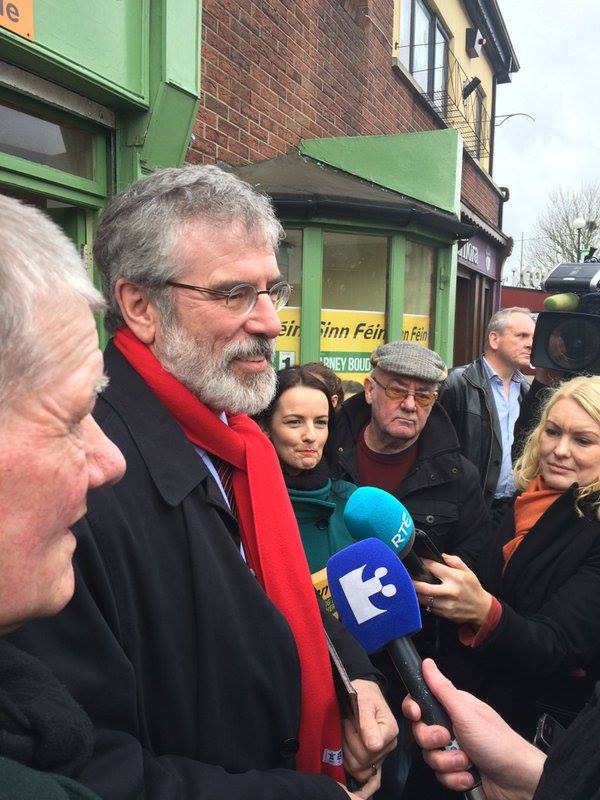
In April, Ireland will celebrate the centennial anniversary of the Easter Rising, the failed rebellion of an overpowered band of Irish republicans.![]()
The heavy-handed response of British troops ended up martyring the republican cause, their lethal overreaction ultimately changing, and hardening, Irish public opinion in favor of independence from the United Kingdom.
Under the penumbra of this year’s centennial celebrations, Irish voters will go to the polls on February 26, after Enda Kenny, Ireland’s Taoiseach (prime minister) announced last week the dissolution of the Irish parliament, the Dáil, to ask voters to reelect his center-right Fine Gael, along with its junior coalition partner, Ireland’s social democratic Labour Party.
But polls show that the party with the most momentum is Sinn Féin, which hopes to capitalize on several factors toward what would be a historic victory. Hoping to peel off disaffected Labour voters, Sinn Féin might even be within striking distance of first place, given that no single party will come close to an absolute majority.
There’s every expectation that Sinn Féin could easily double its 2011 performance of 9.9%, giving the hard-left republicans their best showing in any general election in the history of the Republic of Ireland. The latest Millward Brown poll, published last weekend, gives Fine Gael just 27%, with 22% for the more socially conservative Fianna Fáil and 21% for Sinn Féin. Labour falls down to just 6%, while a bevy of independents, ranging from right-wing Catholics to proponents of drug legalization, are winning another 22% of the vote. In a Thursday debate, the other party leaders attached Adams not for his party’s anti-austerity stand, but for his party’s principled opposition to Ireland’s special criminal court, which many critics argue violates the principle of due process.
Labour leader Joan Burton literally kicked off the new year by falling out of a boat. The party and its voters lean far to the left of the policies enacted over Kenny’s five-year government, ceding space on the left end of the political spectrum to Sinn Féin. Even in better circumstances, the travails of the Liberal Democrats in the United Kingdom and the Free Democratic Party in Germany show that the role of junior coalition partner is thankless – voters seem to give them no credit for the successes and more than their share of the blame for the failures. Ireland’s Green Party lost all six of its seats in 2011 after a stint in government alongside Fianna Fáil.
With or without Labour, however, Fine Gael is unlikely to have enough seats to form a majority. So if Sinn Féin, as expected, finishes in a strong third place, it could cause a political earthquake with aftershocks felt in London, Washington and Brussels. Both Fine Gael’s Kenny and Fianna Fáil’s leader, former foreign affairs minister Micheál Martin, have ruled out joining a coalition government with Sinn Féin. That could mean new elections later this year or a possible ‘grand coalition’ between the two center-right parties. They have been reluctant to embrace such a coalition, in part because it could eventually make Sinn Féin an even more powerful contrast in opposition.
In one sense, it’s great news that Sinn Féin is waging its political fight as a normalized political party, the same way that the nationalist left does today in the Basque Country, and not through the armed struggle of political terrorism (even if Sinn Féin, as a formal matter, was always separate from the more militant Irish Republican Army).
It would be a fitting emotional result on the eve of the Easter Rising’s centennial for the party that the Republic of Ireland’s founding father, Éamon de Valera, once led long ago, long before a series of party splits that led to de Valera’s founding of Fianna Fáil and Sinn Féin’s radical turn in the post-independence era.
But it’s not nostalgia that’s propelling Sinn Féin in 2016. Nor is it widespread love for Sinn Féin’s leader, Gerry Adams, whose past IRA ties make him and his party especially toxic as a potential coalition partner.
Instead, it’s the two currents that have jolted the European Union for the last decade – the dual rise of anti-austerity politics and populist euroscepticism. For the rest of mainstream Europe and the United States, the political rise of Sinn Féin could complicate ties with a country that’s historically been an enthusiastic member of the European Union, a case study for the EU’s approach to economic policy and a key strategic player in U.S.-European relations.
Economic growth alone might not be enough today’s political climate

It’s no surprise that voters in Ireland are weary of economic pain after years of what amounts to a grinding internal devaluation. Voters in the 2011 election angrily turfed out Fianna Fáil, which had been Ireland’s “natural party of government,” ruling for 61 of the republic’s then 79-year history. The electorate blamed Fianna Fáil and former prime minister Bertie Ahern, who stepped down in 2008 after 11 consecutive years in power, for Ireland’s housing bubble and the economic recession that resulted from the triple crunch of the 2008-09 global financial crisis, Ireland’s resulting bank failures and the eurozone’s sovereign debt crisis.
In November 2010, Ireland accepted a €85 billion bailout from the European Union and the International Monetary Fund after the Irish government intervened to nationalize and shore up its collapsing banking industry. That lumped Ireland alongside Portugal, Italy, Greece and Spain in the unflattering ‘PIIGS’ category of Europe’s most troubled economies. The Fine Gael-led government has largely implemented the terms of that bailout, and Kenny has a record of slow and steady progress to show for it. Ireland exited its bailout program in 2013, and negotiations over the liquidation of the Anglo Irish Bank, nationalized at the height of the Irish banking crisis, allowed the government to defer its obligations for decades. Despite Kenny’s work to cut the deficit, he managed to preserve Ireland’s attractive 12.5% corporate tax rate, a point of pride among political elites who have aggressively marketed Ireland as a business-friendly jurisdiction (though perhaps not to Ireland’s struggling working class). Earlier this month, the Irish unemployment rate fell to 8.6%, its lowest level in seven years, far off a high of over 15% in early 2012 and far below unemployment in Spain and Greece, the two countries still suffering the most from the eurozone crisis. Moreover, Ireland’s GDP growth surged to 5.4% in 2014 and the latest estimates for 2015 pit growth at 6.6%, higher than any other country in the European Union.
Despite the recovery, Ireland is still feels a far ways off from the once-mighty “Celtic Tiger” days. For many voters, however, talk of “recovery” is still premature, and economic inequality and uncertainty remain high, most especially for the unemployed. Sinn Féin, now the only major political party that didn’t embrace the EU/IMF bailout, has become the sole clarion of anti-austerity sentiment in Ireland.
A look across the Atlantic world shows that it is not surprising that Sinn Féin is winning so much support. Moreover, in a world where Alexis Tsipras and SYRIZA are running Greece’s government, where anti-austerity movements like Podemos have scrambled Spanish politics and communists are part of a left-front government in Portugal, where hard-left Jeremy Corbyn leads the British Labour Party and democratic socialist Bernie Sanders is holding his own in the early Democratic Party presidential primary contests in the United States, it is clear that there’s growing appetite for a more full-throated brand of leftist policy. That’s especially true among young voters who, in Ireland, associate Sinn Féin more with Corbyn-style socialism than with political terrorism.
Even in ‘case study’ Ireland, European integration is losing popularity

A Sinn Féin surge in 2016 would also demonstrate that even in Ireland, which enthusiastically joined the European Economic Community in 1973 and benefited handsomely from European cohesion and structural funds to develop its economy, the European project is losing its luster. Sinn Féin does not want Ireland to leave the European Union or even the eurozone, but it is still the country’s least EU-friendly major party, and that won it more MEPs than any other party except Fine Gael in the May 2014 European parliamentary elections.
It’s true that Ireland often plays a plucky role in European affairs. Twice in the past 15 years, Irish voters initially rejected attempts at greater European integration, the Nice Treaty in June 2001 and the Lisbon Treaty in June 2008 (treaty changes are deemed constitutional amendments in Ireland and, accordingly, subject to referendum). Moreover, those rejections came in far rosier economic times.
It’s impossible to know how a newly empowered Sinn Féin could impact the coming “Brexit” referendum later this year or in 2017, in which British voters may choose to leave the European Union altogether. Though both the Scottish National Party and Sinn Féin nominally support the campaign for the United Kingdom to stay in the European Union, both parties and their respective causes of Scottish and Irish nationalism could benefit greatly from the Brexit chaos. A full Brexit could easily result in economic, political and diplomatic pandemonium, giving the SNP a hook for a new independence referendum. In the same way, Brexit might also unleash renewed interest in reuniting Northern Ireland with Ireland or, at minimum, potentially disrupt the gains of two decades of Northern Irish peace and the tenuous power-sharing agreement between Protestant unionists and Irish Catholic republicans.
Meanwhile, Sinn Féin has time to wait.
Increasingly, the Catholic-heavy social conservatism that Fianna Fáil has traditionally promoted is less in sync with an electorate that’s far more tolerant of abortion and LGBT rights than a generation ago. The most recent Fine Gael government in 2013 enacted legislating decriminalizing abortion for the first time (when the life of the mother is at risk). In 2015, Irish voters overwhelmingly embraced same-sex marriage. Sinn Féin, though many of its grassroots supporters are religious traditionalists, has increasingly shifted to a progressive viewpoint on both issues.
Adams, age 67, still dogged by legal troubles and the moral ghosts of the 1970s and 1980s, will not go on forever. Deputy leader Mary Lou McDonald is especially popular in Ireland’s south, and as the heir apparent for the party leadership when (and if) Adams retires, her succession would go a long way in cleansing the party from its most unsavory connections to the Troubles in Northern Ireland. McDonald, born in 1969 to a middle-class Dublin family, represents a generational change from Adams and the IRA years, and her political star has been rising steadily for a decade. As one of two Sinn Féin representatives in the European Parliament, McDonald focused on employment matters, impressing policymakers from Brussels to Dublin. Just as Nicola Sturgeon has proven far more adept in Scotland than her mentor Alex Salmond, McDonald in Ireland could catapult a post-Adams Sinn Féin even higher in the years to come.
As Ireland commemorates the 1916 rising later this spring, its political leaders may still be in negotiations over forming a new government. If Sinn Féin meets or exceeds current expectations, however, Ireland’s political scene will find itself as “changed utterly” by 2016 as by 1916.